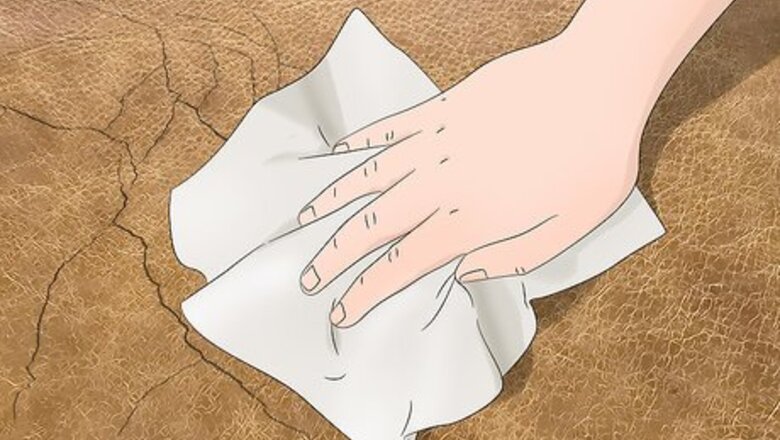
views
Rehydrating Leather with a Conditioner
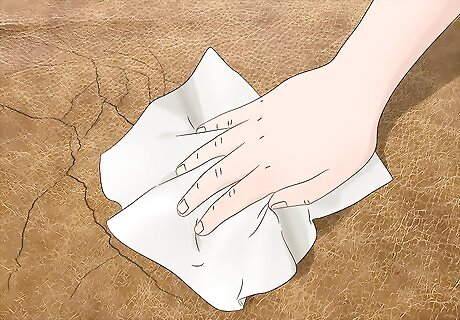
Wipe off the leather with a cleaner and a microfiber cloth. Using a store-bought leather cleaner is the easiest way to prepare the cracked surface for repairs. Spray the cleaner on the cloth, then wipe away any grime on the leather. Rub along the leather’s grain to avoid deepening the cracks. If you don’t have a commercial cleaner, mix together 1 part mild soap with 8 parts distilled water. Use baby soap or a liquid dish or hand soap. Using a small amount of water is a safe way to rinse off soap. Dampen the microfiber cloth, wringing out the excess moisture, then wipe the leather along its grain.

Wait for the leather to dry before treating it. Touch the leather to check its condition. Cracks form when leather dries out, so your item most likely will feel dry within 5 to 10 minutes. To speed up the drying process, wipe the leather with a microfiber cloth. Make sure the surface feels dry to the touch so the soap or cleaner doesn’t get in the way of the conditioner.
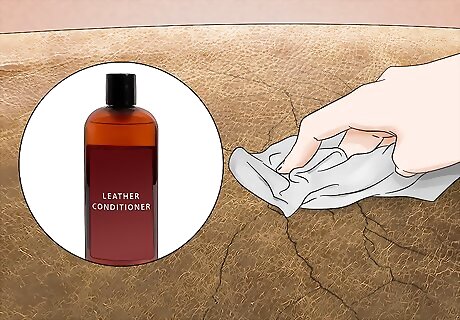
Dab a strong leather conditioner onto the cracks. Select a bottled conditioner designed to restore and rehydrate leather. Put a small dollop of the conditioner on your finger or a soft applicator like a sponge or cloth. Then, rub the conditioner directly into the cracks in order to clean out the fabric’s pores and prepare them for deeper conditioning. Leather conditioner is available wherever leather items are sold, particularly online, at general stores, and at some clothing shops. The leather will absorb the cleaner right away. This happens with items that have dried out over time. Regular conditioning keeps leather soft and pliable.
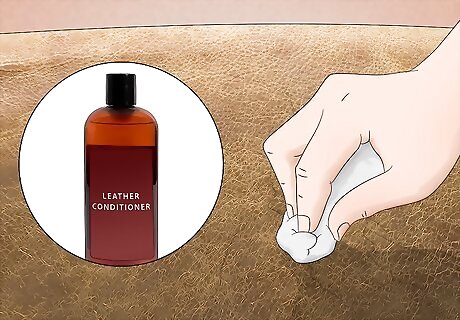
Smooth out the cracked areas with additional conditioner. Apply a generous amount of conditioner to the applicator pad. This time, scrub over the cracks and the areas around them. Continue scrubbing along the grain. The leather will become a more consistent color, hiding the cracks. If the leather hasn’t been conditioned in a while, consider treating the entire item now. Conditioning it prevents new cracks from forming elsewhere.

Let the leather rest for 2 hours until it feels dry to the touch. Check the manufacturer’s instructions for the recommended drying time. The leather needs plenty of time to absorb all of the conditioner. Wait until it feels dry to the touch before continuing to treat it. If you have the time, let the leather dry overnight. Waiting a little longer gives the conditioner plenty of time to rehydrate the leather.
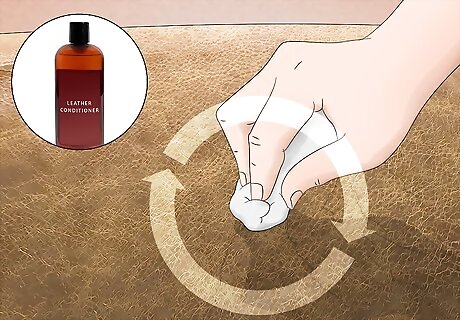
Condition the leather again if the cracks are still visible. Depending on the conditioner, you may need to treat the leather multiple times. Spread more conditioner on an applicator pad and scrub it across the cracks. Check the leather again the next morning after giving it plenty of time to dry. Continue treating the leather until the cracks are gone or the leather stops absorbing the conditioner. If it stops absorbing the conditioner but the cracks are still visible, you will need to try a filler or dye. Valerie Michael Valerie Michael, Leather Repair Expert When beloved leather goods crack and peel, restoration starts from within. Clean gently to remove dirt while maintaining suppleness. Massage conditioner into distressed areas to revitalize. For cracks, apply a flexible filler along the length of the fissure. Once bonded, buff to a subtle sheen. With care and skill, even well-worn leather can be revived to its former strength and beauty.
Sealing Cracks with a Leather Filler
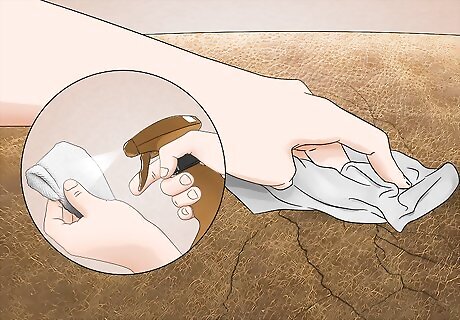
Wash grime off the leather with soap or a leather cleaner. Select a bottled specialty leather cleaner or a mild soap. Baby soaps and mild dish and hand soaps are safe on leather. Make sure the soap isn’t designed for harsh surfaces or grease. Put the cleaner on a microfiber cloth and wipe up any dirt and debris still on the leather. If you use soap, mix it into distilled water first. Then, lightly dampen a cloth with the soapy water.

Wait overnight for the leather to dry completely. Any moisture on the leather will prevent the filler from settling into the cracks. To encourage the leather to dry faster, wipe it off with a clean microfiber cloth. Make sure the leather looks free of grime and feels dry to the touch before attempting to treat the scratches. Cleaning up leftover soap with water is fine, but use a lightly dampened cloth. Too much water exposure damages leather other time. Store your item in open air away from direct sunlight. Exposure to harsh heat and sunlight damages and fades colored leather.
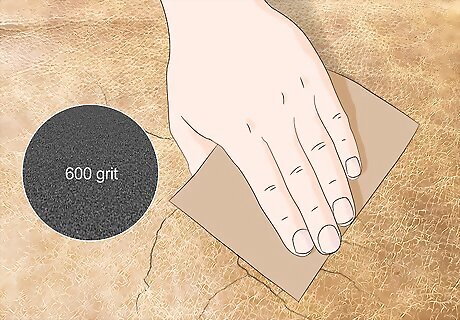
Smooth the cracks with a piece of 600-grit super fine sandpaper. Apply gentle pressure while treating the cracks. Keep wearing them down until the leather feels uniformly smooth to the touch. Then, wipe it off with a dry microfiber cloth. Make sure the cloth removes all of the dust from the cracks so you can fill them in. Using higher grit or ultra fine sandpaper is safe, but avoid harsher sandpapers. Lower-grit papers are coarser and more likely to leave noticeable scratches.
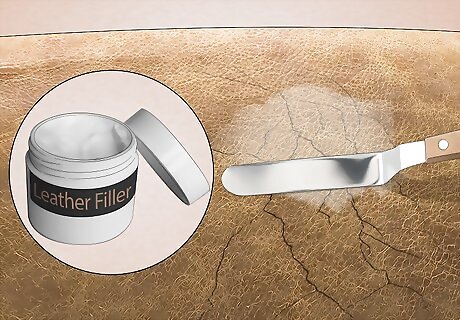
Spread a leather filler over the cracks. Leather fillers are paste-like products that come in small tubs. Pick up some of the paste with a palette knife, then brush it onto the cracks to fill them with a thin layer of paste. Apply additional paste until all the cracks appear filled. Palette knives are thin and fairly blunt, making them a great choice for spreading the paste. If you don’t have one, use another blunt object like a credit card. Avoid sharp knives or other objects that will scratch the leather. Leather fillers are available online and at some general stores. They are often sold in kits that may include a sanding pad and an applicator knife. EXPERT TIP Mallika Sharma Mallika Sharma Certified Leather Care Technician Mallika Sharma is a Certified Leather Care Technician and the Founder of The Leather Laundry, a niche spa service for luxury leather gear in India. Mallika specializes in leather cleaning, coloring, repairing, and restoring for shoes, handbags, jackets, wallets, belts, and sofas. She holds a Master’s degree in Finance and Investment from the University of Edinburgh Business School. Mallika is a certified Professional Leather Care Technician and trained with the globally reputed leather care company, LTT in the United Kingdom. Mallika Sharma Mallika Sharma Certified Leather Care Technician Fill leather holes before coloring them. Small holes, tears, cracks, or other damage in leather can be filled in and patched up using a special filler cream or putty. Once the damaged area is filled and smoothed out, use a tiny fiber tip brush or applicator to gently blend leather dye, paint, or pigment over the patched area in a color that closely matches the surrounding material.
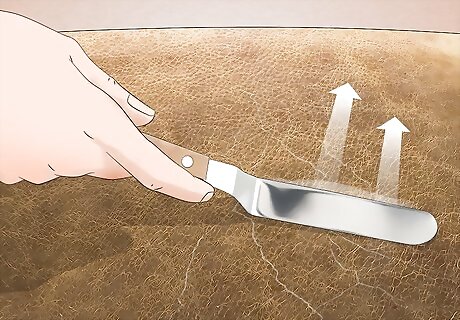
Remove excess paste with the edge of the knife. After spreading the filler, you will probably have a fair amount outside of the cracks. Tilt the palette knife sideways, then scrape its edge gently over the leather. It will pick up the remaining paste. Continue removing the paste until you can no longer see it outside of the cracked areas. Place the excess filler in the cracks, back in the container, or wash the knife off in water as needed to remove it.
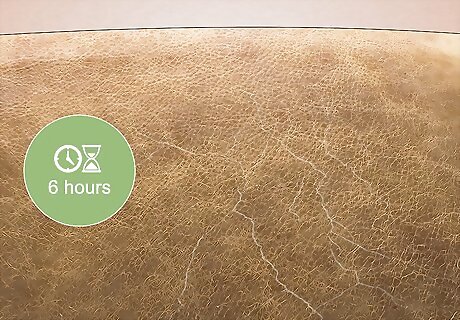
Let the leather dry for 6 hours until the filler solidifies. Leave the filler exposed to open air so it dries faster. To protect your leather item, keep it out of direct sunlight and away from extreme heat. Heat sources like heaters and ovens run the risk of drying out the leather, causing it to crack further.
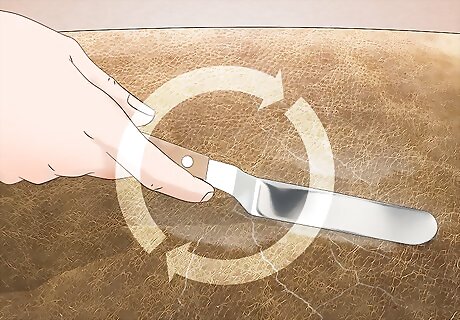
Apply more coatings of filler as needed to even out the cracks. The filler shrinks as it dries, so you will need to apply a second layer. Spread more filler with a palette knife or a similar blunt object. Scrape up the excess, then wait for then new layer to dry. When the leather is repaired, the cracks will no longer be distinguishable. Depending on how deep the cracks are, you may need to apply additional layers of filler. Some cracks require as many as 5 coatings. Repeat the treatment until the cracks are well-filled.
Blending Cracks with a Leather Dye
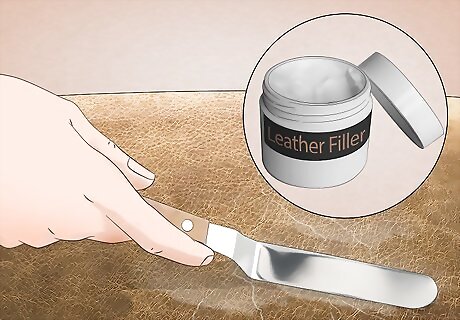
Treat cracks with leather filler to blend the coloring in better. If you don’t use filler first, you apply the dye or paint directly to the leather. This is enough to repair most cracks, but they may still be easy to spot. Filler is colorless, so it does a better job of permanently hiding bad cracks. For particularly deep or ugly cracks, add filler first so they don’t stand out as much.

Sand the leather with 600-grit sandpaper and wipe it clean. Smooth out the cracks to prepare them for the dye. Press the sandpaper or sanding pad down gently and rub along the leather’s grain. Make sure the leather feels smooth to the touch. Wipe up the dust with a clean microfiber cloth. Use the cloth to clear out any dust that falls into the cracks. Leftover dust prevents the leather from absorbing the coloring evenly.
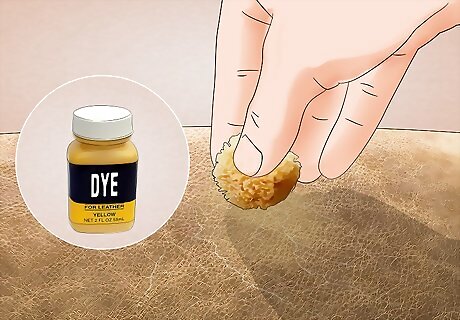
Spread a thin coat of leather dye over the cracks with a sponge. Leather dye comes in a variety of colors, so choose a bottle that matches your item. Then, pour a little bit of the dye on a sponge or applicator pad. Rub the cracks to spread the dye into them. Leather dye is available online or at some craft and general stores. They are sometimes sold in kits that include sandpaper and applicator pads. Another way to color cracks is with spray paint and lacquer thinner. Get a matching color of spray paint safe for use on leather. Spray some of the paint on a cloth, then pour the lacquer on the cloth. Rub the cloth against the cracks to color them.
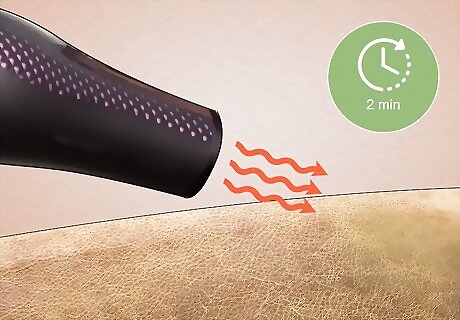
Dry the dye for 2 minutes with a hairdryer set to high. Plug in the hairdryer and point it directly at the dyed areas. Move the heater back and forth across the cracks to prevent the leather from drying out. After you’re done, the layer of dye will be dry to the touch. If you don’t have a hairdryer, try an alternative heat source, such as a heat gun. Be careful, since heat guns can easily burn leather. Move the gun around to prevent any spots from overheating.
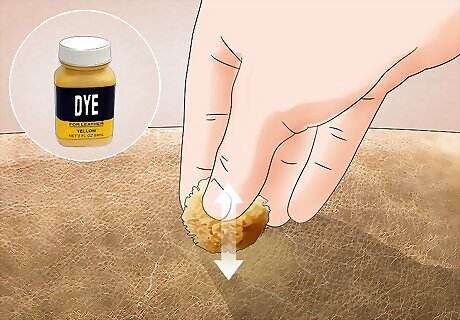
Blend the cracks with multiple coats of dye as needed. Cracks generally require 2 to 5 treatments before they look repaired. Spread more of the dye over the leather. This time, dab some of the dye directly into the crack, then rub the area around the cracks to blend them together. Dry the dye each time with a hairdryer. Keep applying dye until the cracks are indistinguishable from the rest of the leather.

Treat the cracks with a leather sealer to protect the dye. Spray the sealer onto a clean sponge or applicator pad. Then, rub the cracked area, applying a second coating as needed to cover all of the dye. The sealer acts as a conditioner that also protects the cracked area from stains and further damage. Purchase a bottle of leather sealer online or at your local general store.
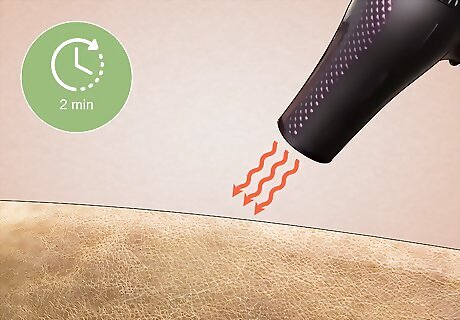
Heat the sealer with a hair dryer for 2 minutes to cure it. Activate the dryer one last time to finish the repair. Hold the heater close to the leather, pointing it directly at the treated area. Move the heater back and forth to prevent the leather from overheating. Once the leather feels dry to the touch, check it to make sure it looks as good as new.




















Comments
0 comment